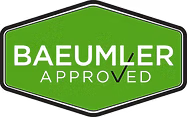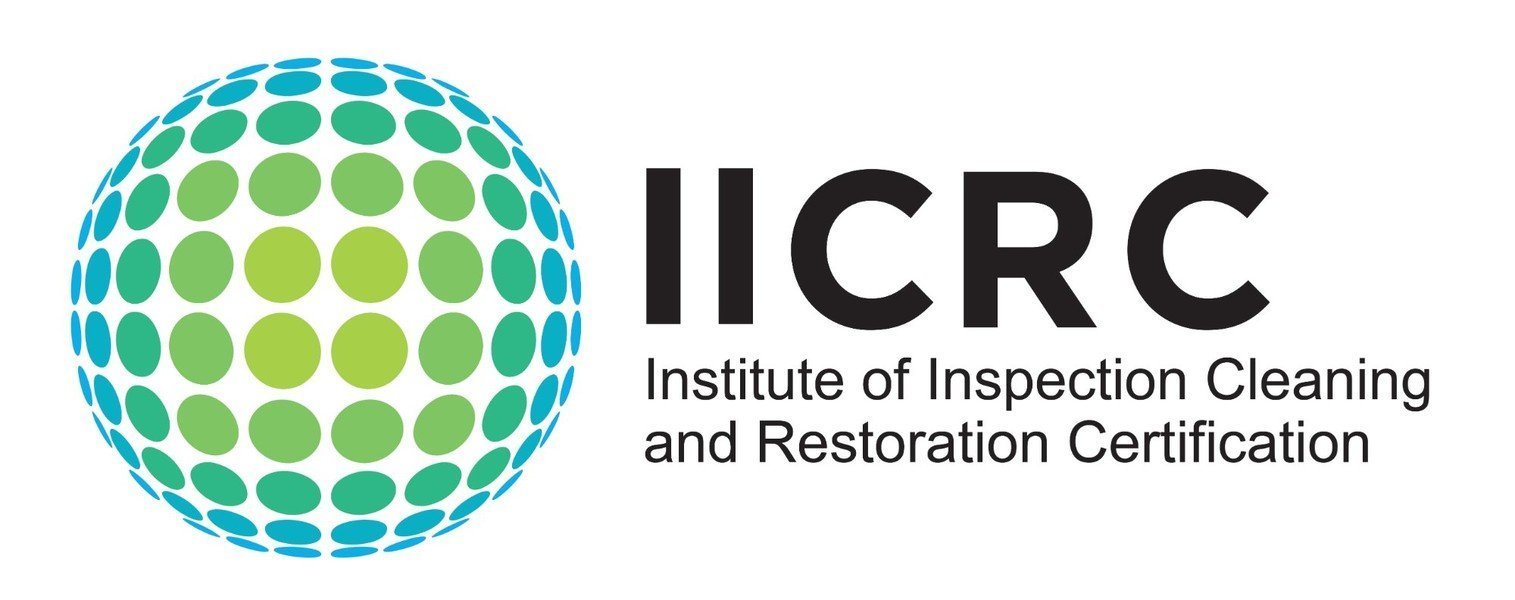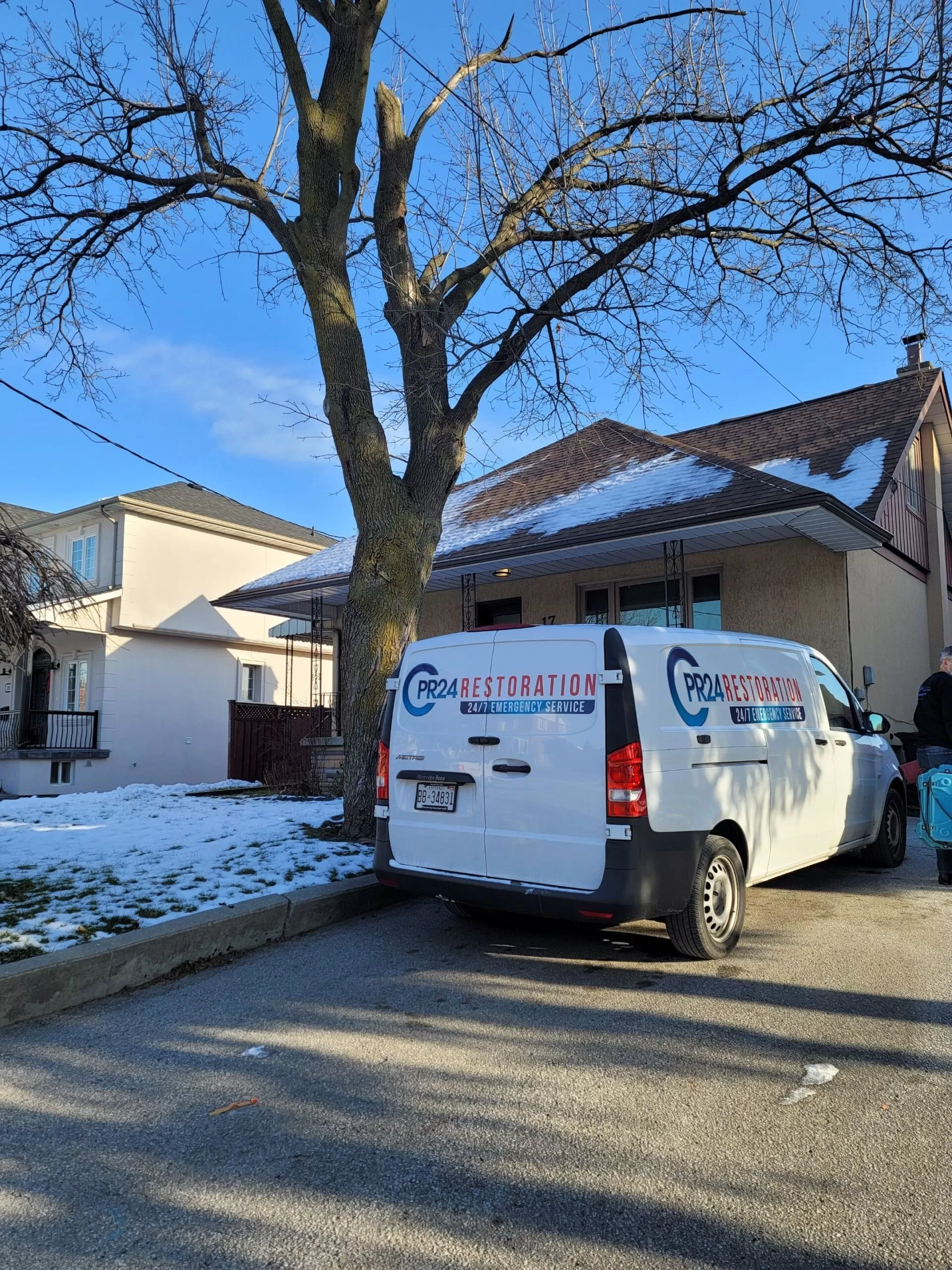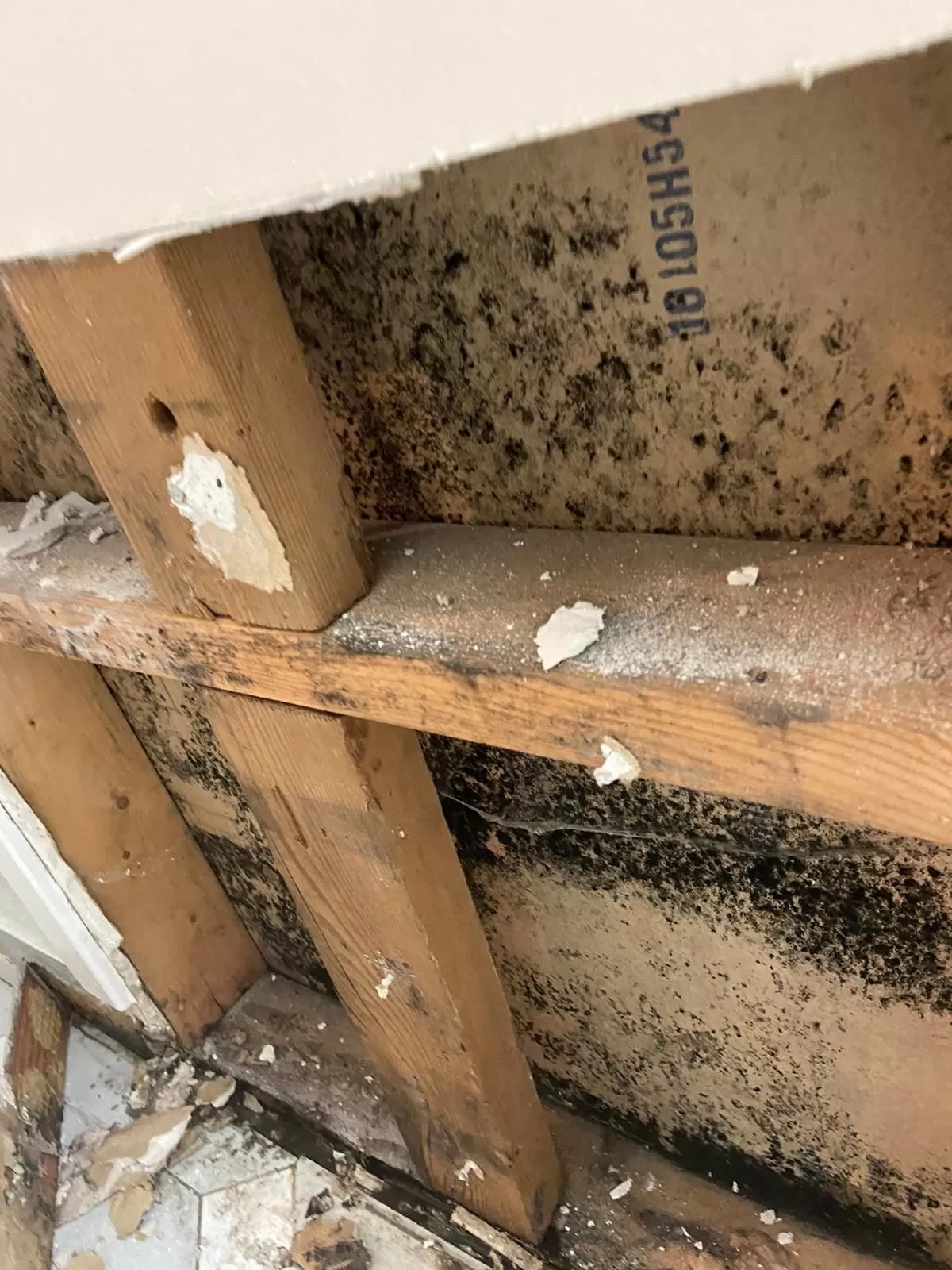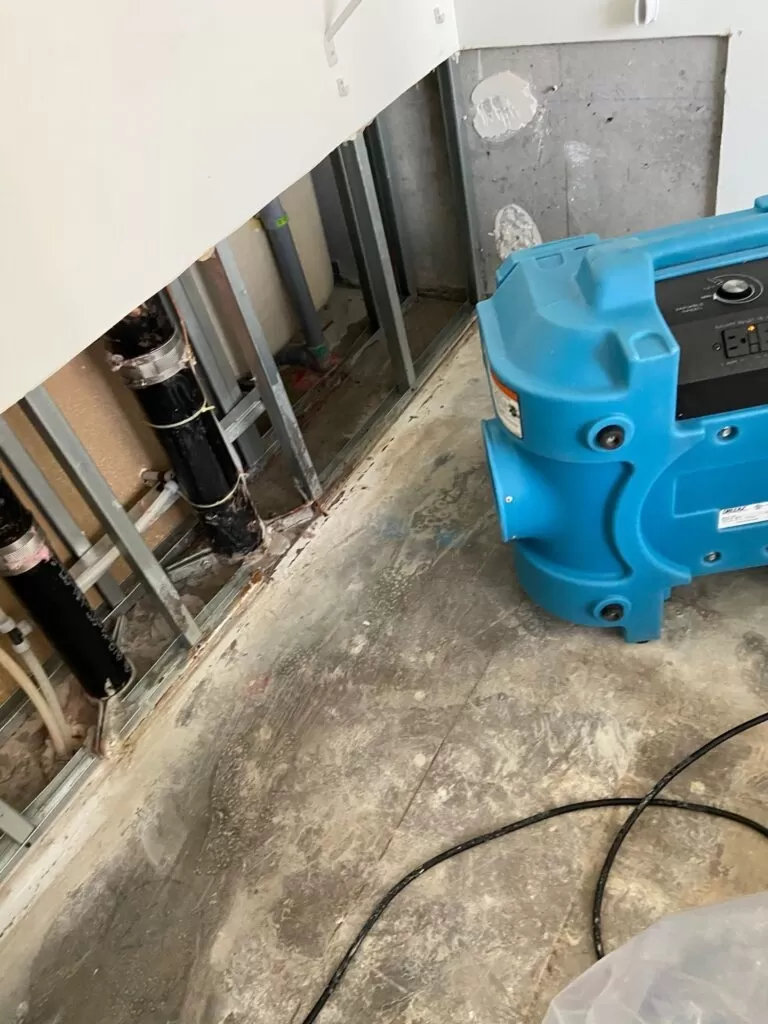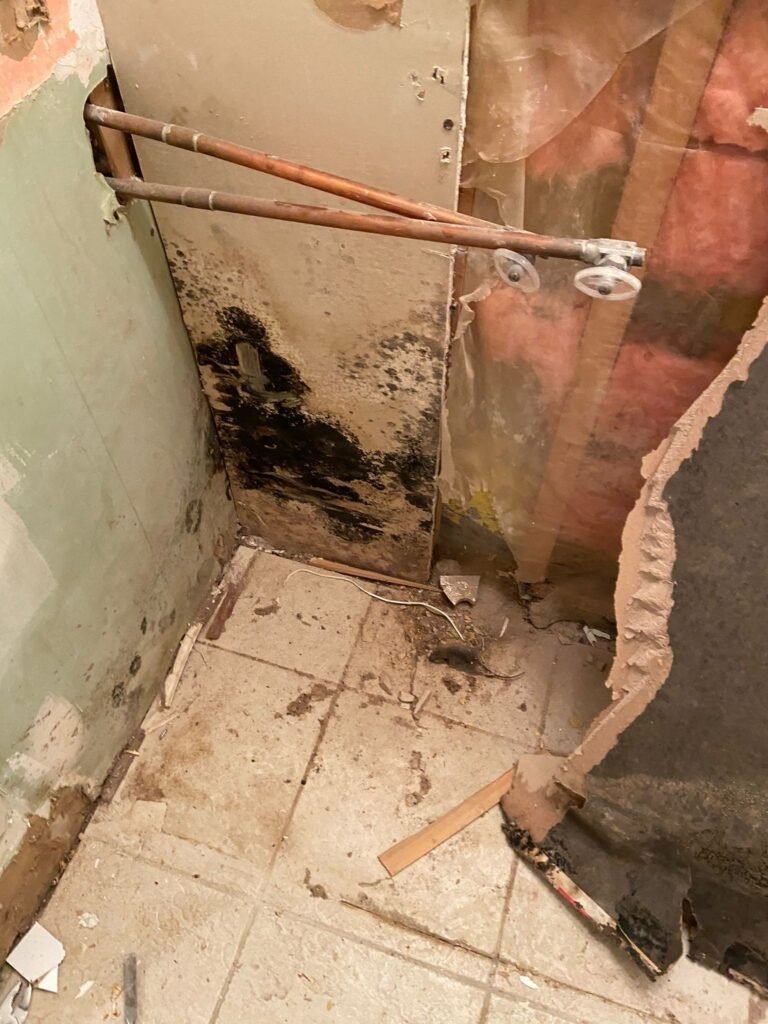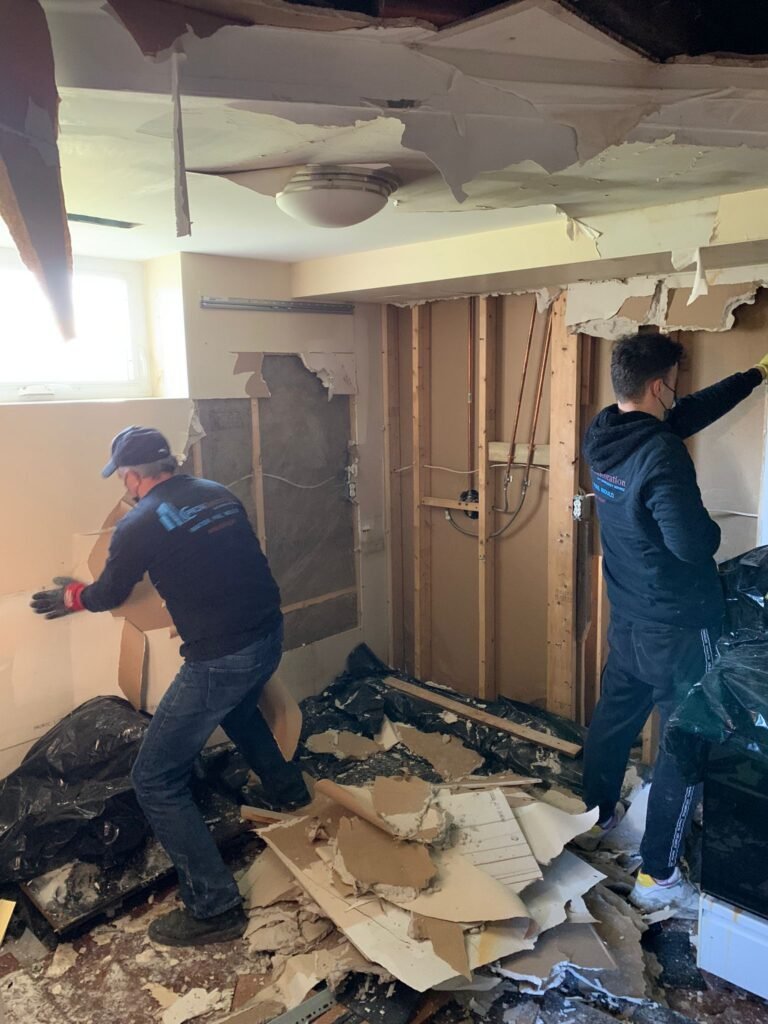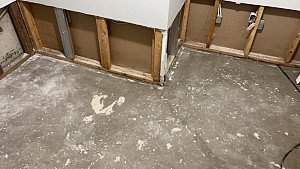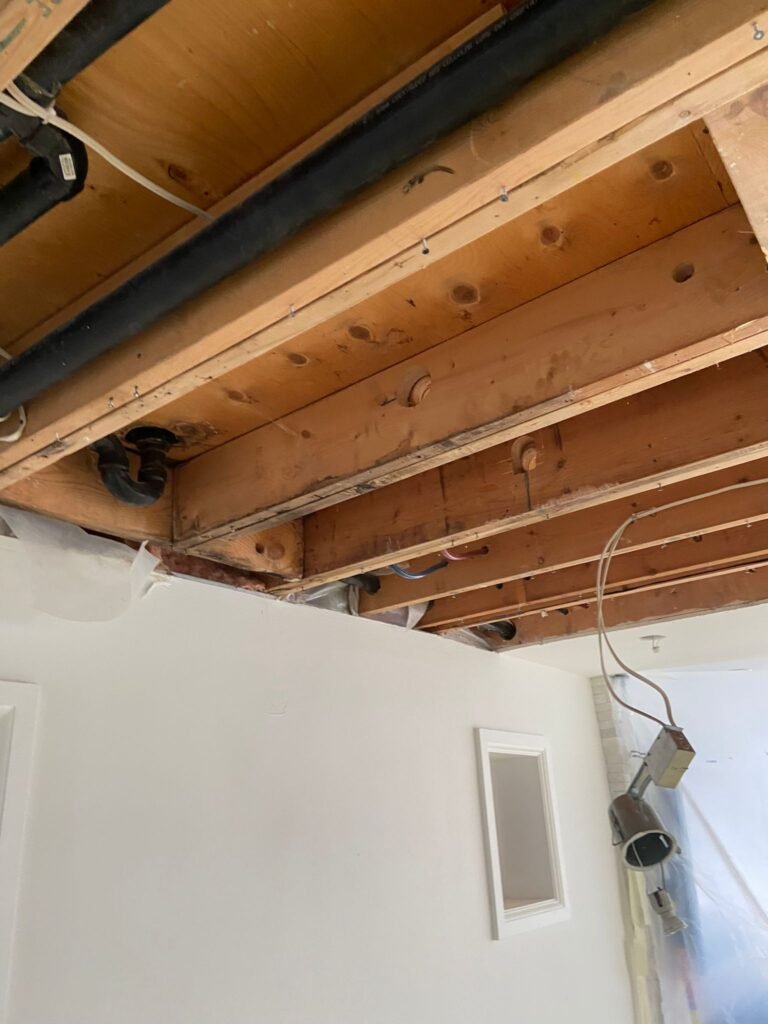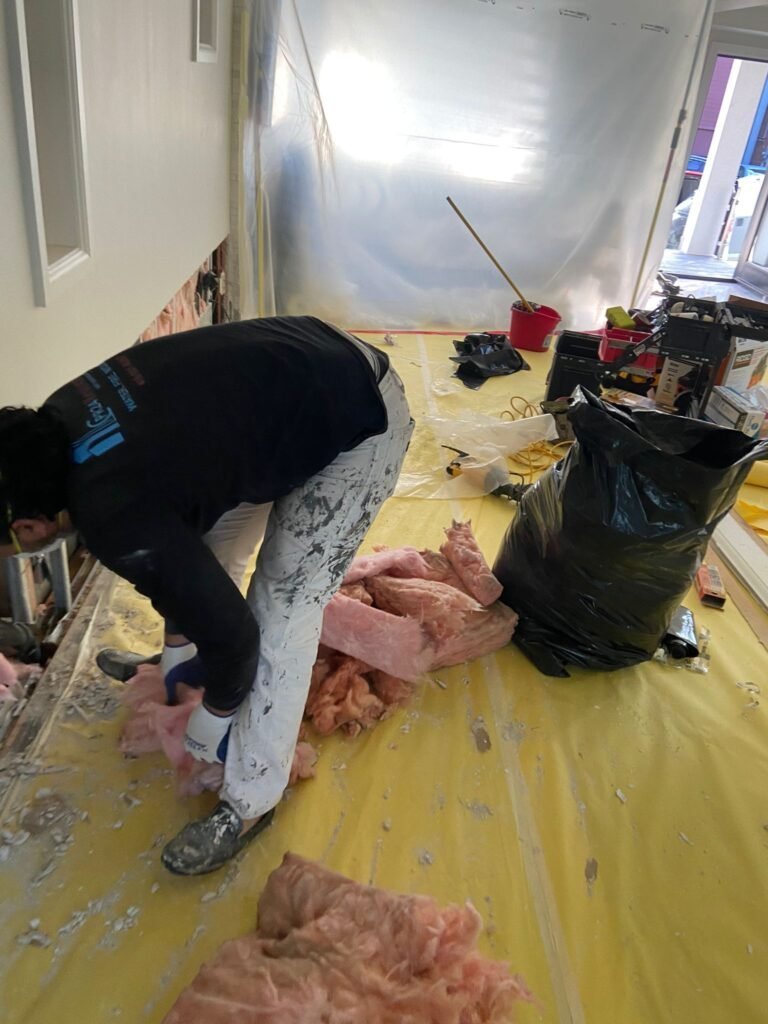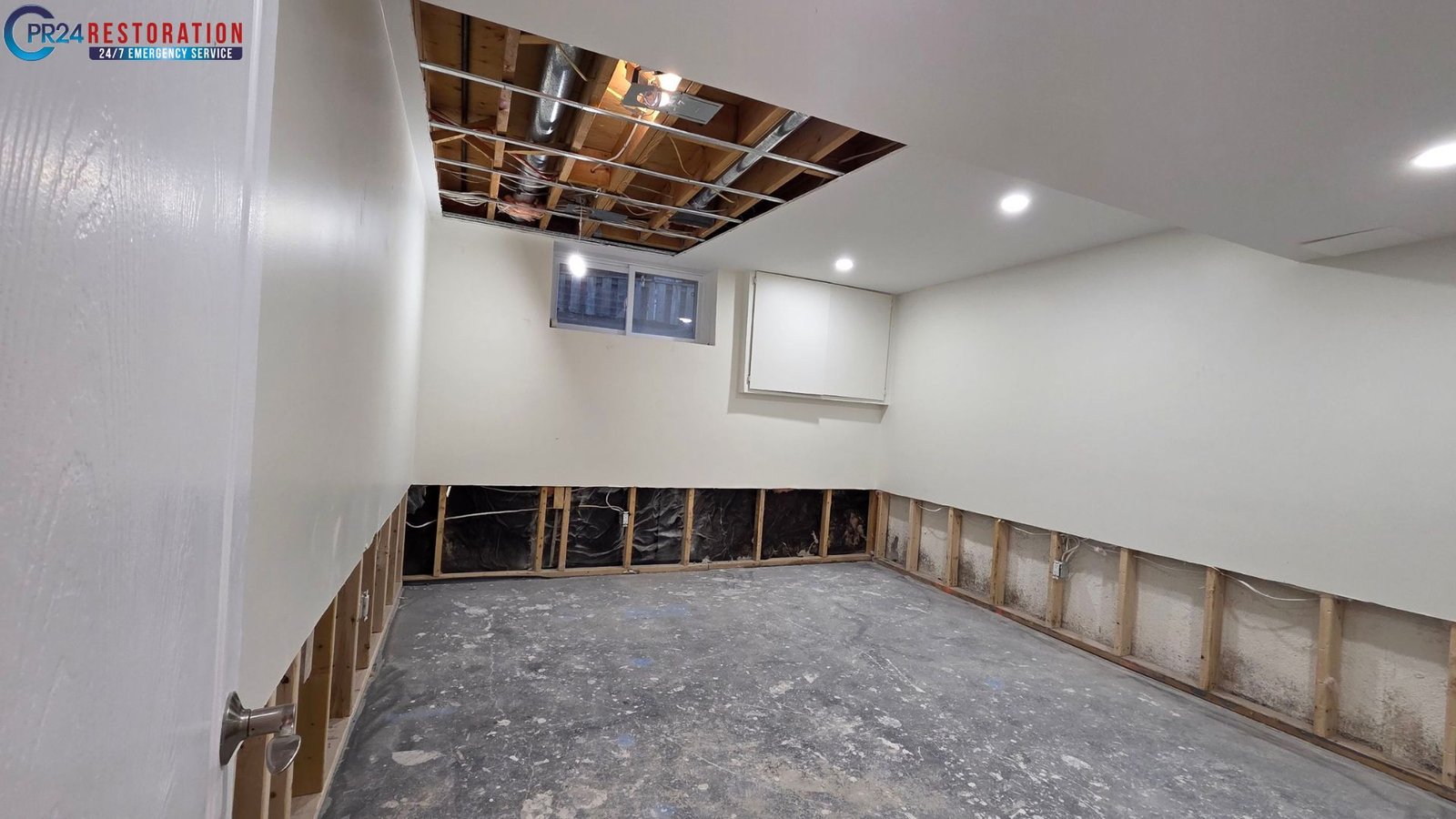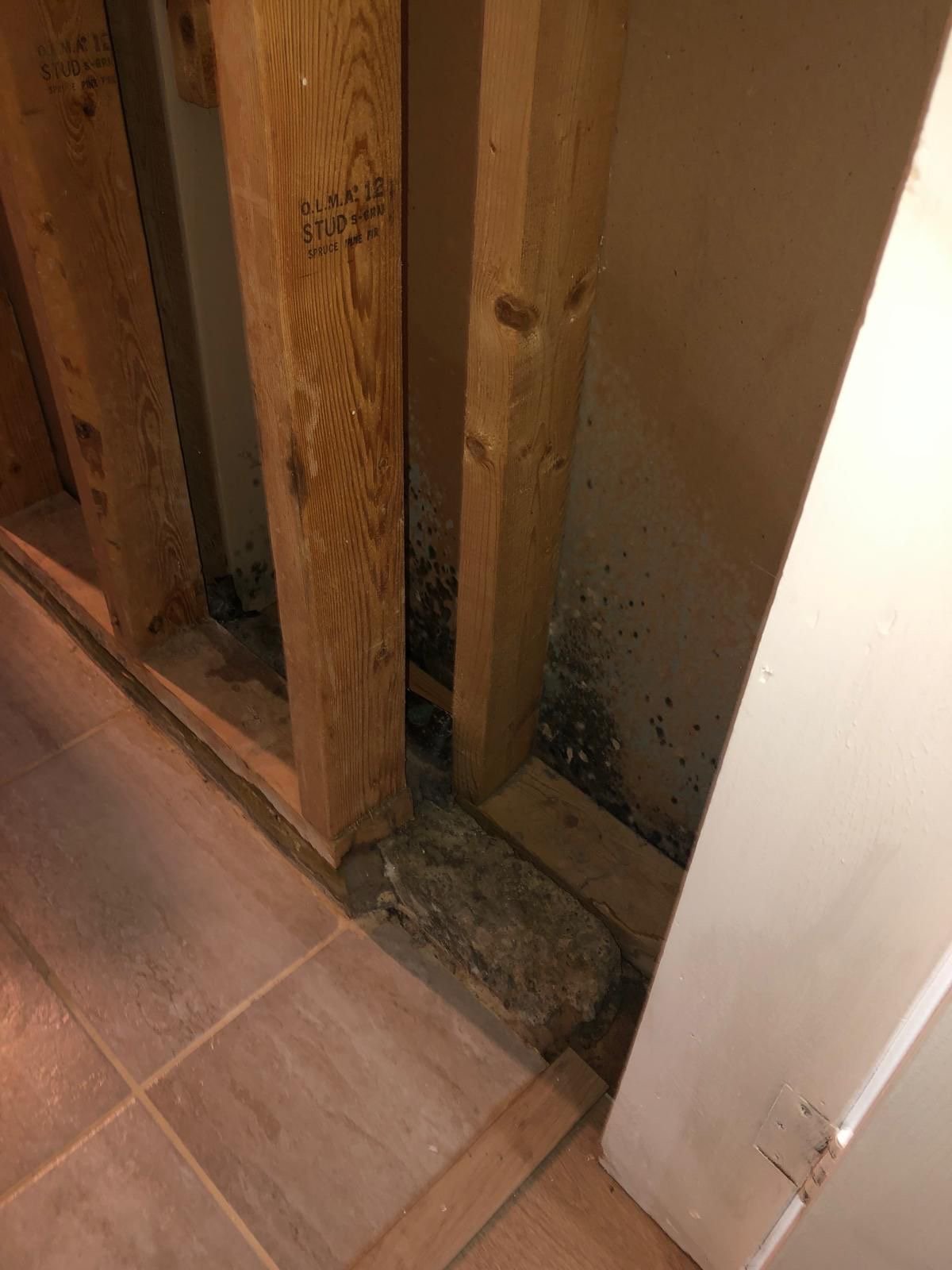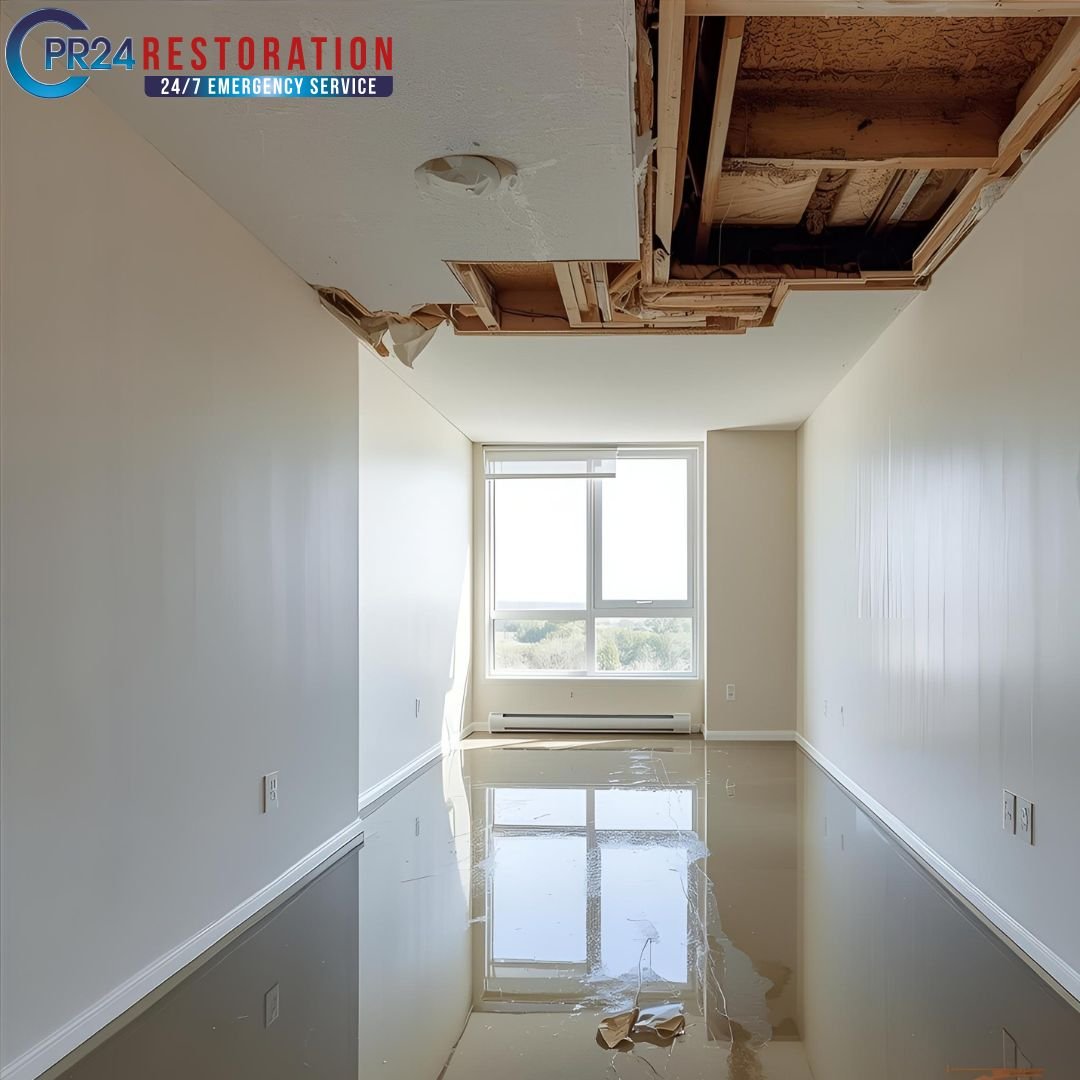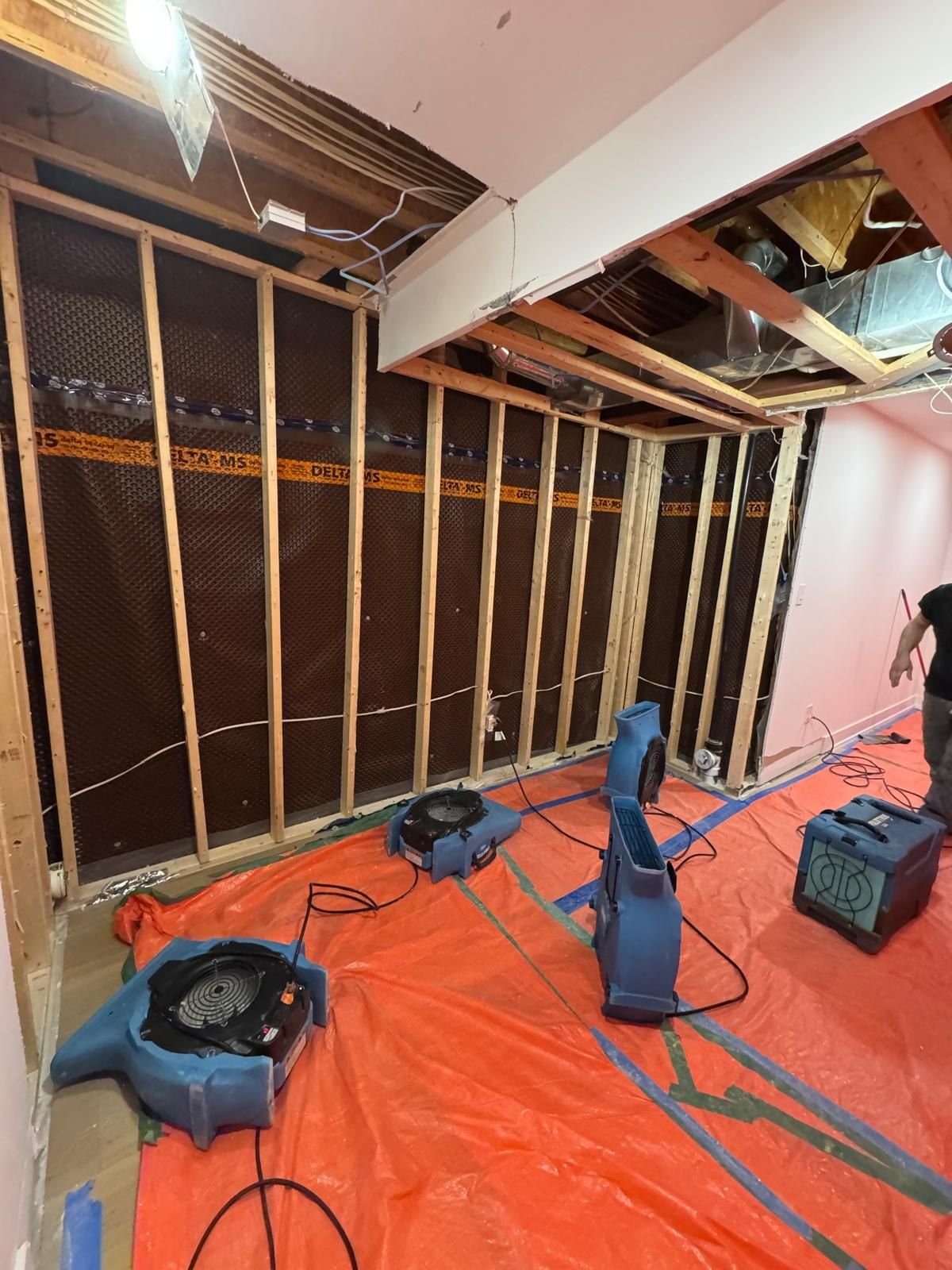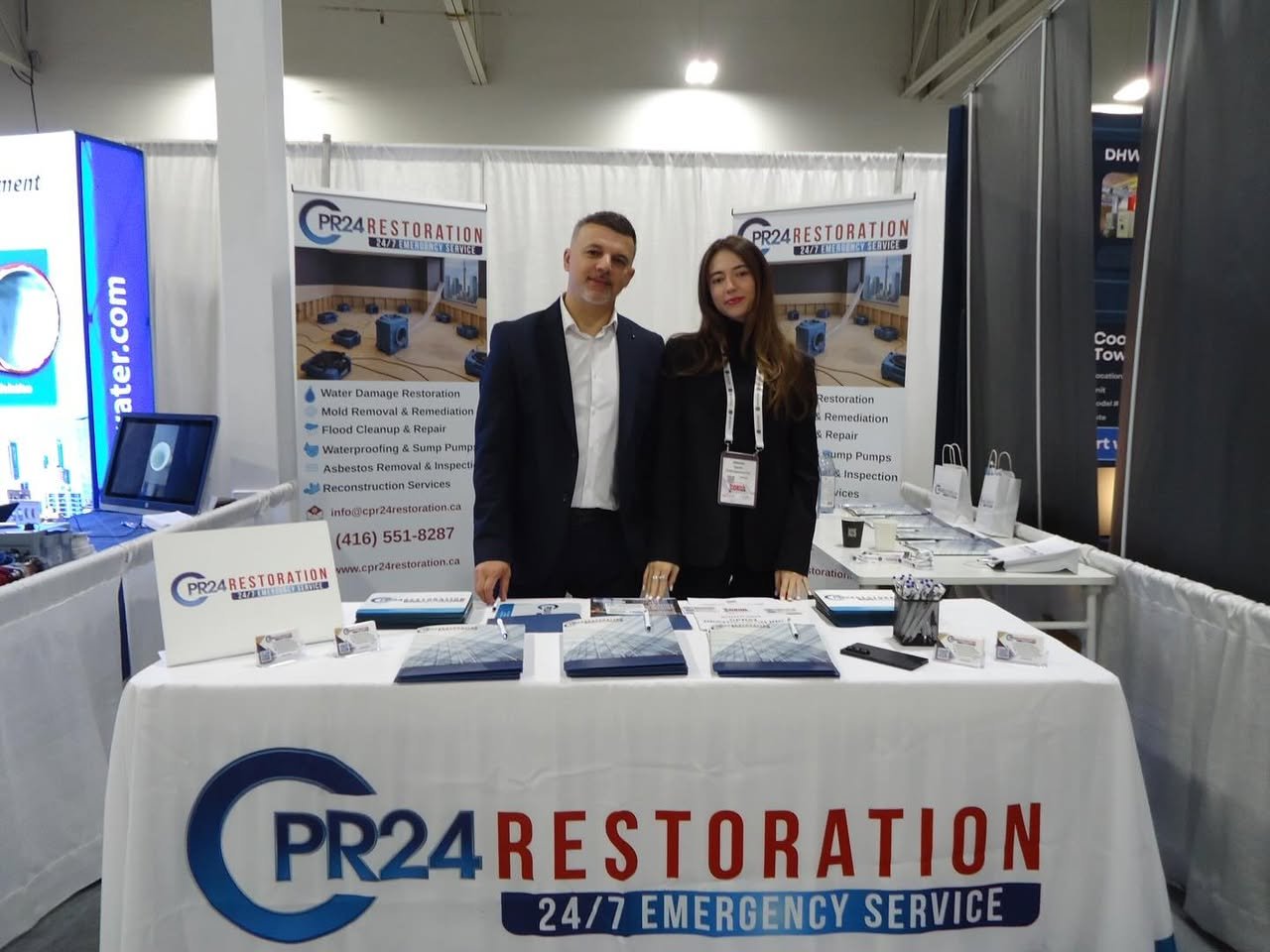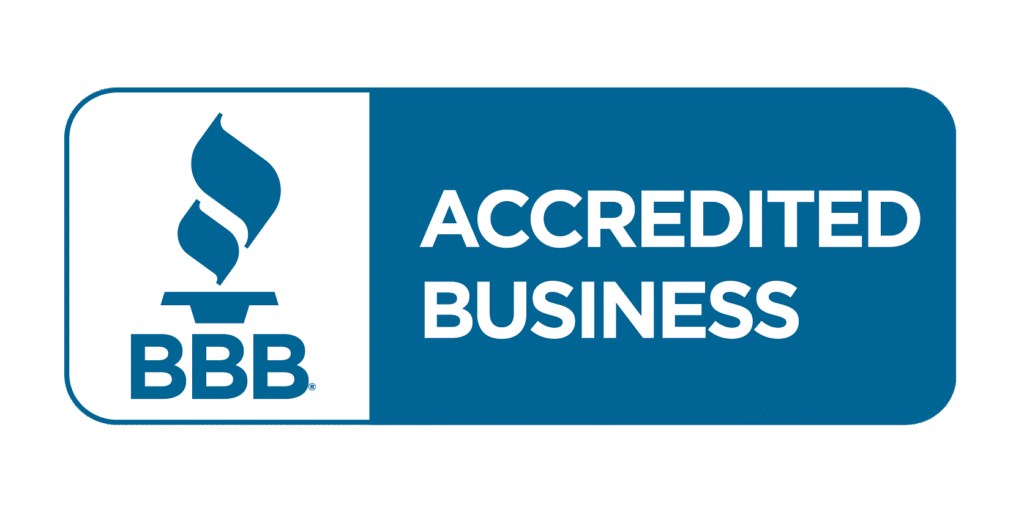Water Damage Burst Pipes
Burst & Frozen Pipe Restoration Toronto
When cold weather begins in Ontario, frozen pipes become a pressing issue across the city. The cold weather greatly impacts the water lines within your property. As water freezes, it expands, exerting immense pressure on pipes, leading to large and/or small leaks.
For business owners, a burst pipe can be an overwhelming disaster. A ruptured line can unleash thousands of gallons of water hourly, resulting in severe water damage.
Trust CPR24 Restoration if there is a burst pipe or flooding on your property. Our experts are highly trained and confident in their abilities to restore any property to its pre-damaged state!
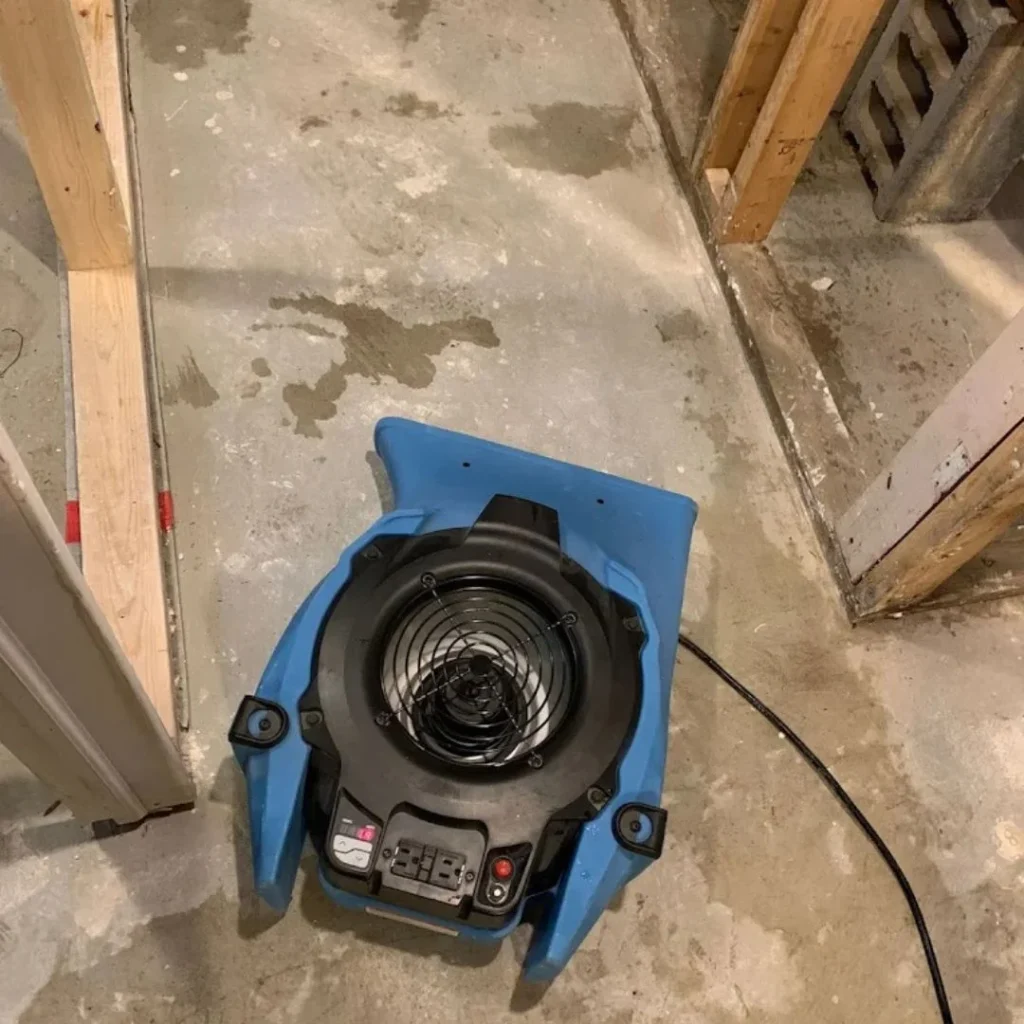
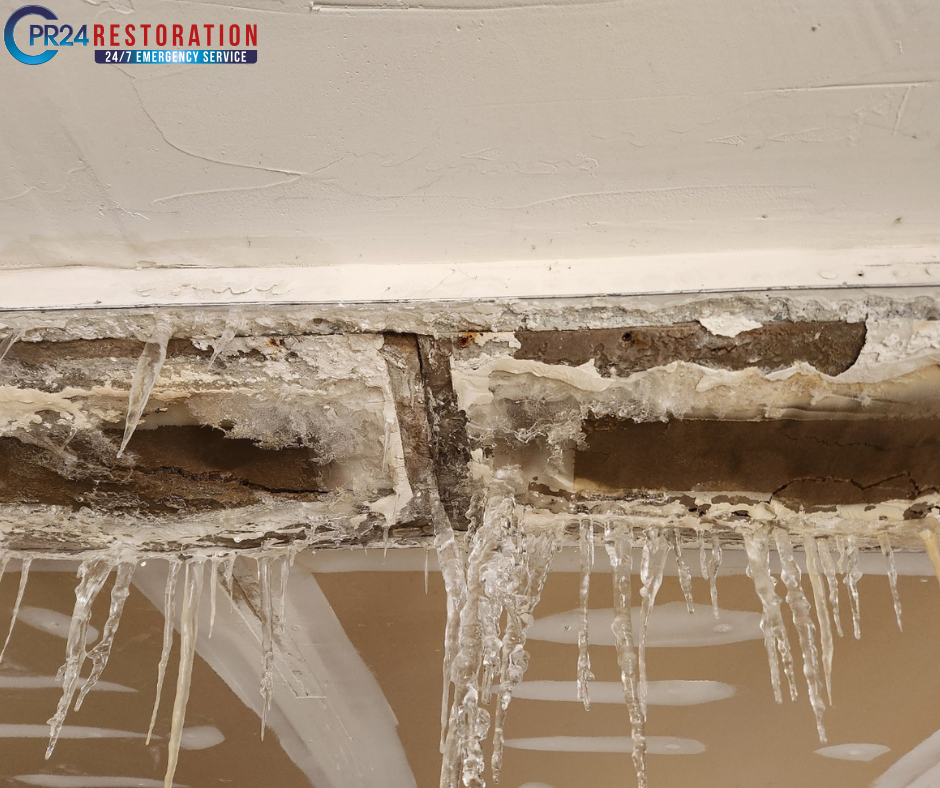
Freezing weather can lead to standing water freezing within exposed pipes. As this frozen water expands, it creates significant internal pressure on the broken pipe. Eventually, the increased water level reaches a point where the pipes burst open.
A burst pipe can release hundreds of gallons of water in just a few hours. This can cause serious damage to walls, floors, ceilings, and your belongings. The longer you allow water to sit, the greater the risk of structural issues and hazardous mold growth.
If you see signs of a water leak or a burst pipe, the first thing to do is turn off the water supply lines. You can start the process of fixing a broken water pipe. Also, you can quickly check your plumbing system.
Our Professional Water Damage Burst Pipe Repair Process
If there is water damage, CPR24 Restoration uses a step-by-step method. We remove extra water to help restore your home. The process includes:
- Extracting standing water and stabilizing the site. This prevents further damage from occurring.
- Utilizing specialized drying equipment. High-quality machines expedite the drying process, removing all excess moisture.
- Removing debris like damaged drywall, carpeting, furniture, and other contaminated materials. Water can ruin personal belongings, requiring disposal.
- Applying antimicrobial treatments as part of mold removal/remediation. These treatments inhibit future mold growth.
- Protecting and restoring salvageable contents. Our team commits to rescuing belongings impacted by water and preserving what we can save with care.
- Monitoring moisture levels in impacted areas. We monitor affected zones accurately, ensuring complete dryness before concluding our work.

Our Professional Water Damage Burst Pipe Repair Process
When a burst pipe causes serious water damage, professional restoration services are important. We help with cleanup and prevent long-term problems. Understanding the water damage restoration process can help you know what to expect and ensure your property receives comprehensive care. Here’s an overview of the typical steps involved in professional water damage restoration:
Emergency Contact and Response
Assessment and Inspection
Upon arrival, restoration Toronto professionals will conduct a thorough assessment of the affected areas:
- Identify the water source and ensure it’s stopped
- Determine the category of water (clean, gray, or black) to plan appropriate safety measures
- Use moisture meters and thermal imaging cameras to detect hidden water pockets
- Assess the extent of damage to structures and belongings
- Create a detailed Toronto restoration plan and provide an estimate
Water Extraction
The next crucial step is removing all standing water from the property:
- Use powerful pumps and industrial-grade wet vacuums for efficient water removal
- Extract water from carpets and padding
- Move furniture and other items to facilitate thorough extraction
Removal of Damaged Areas & Materials
Professionals will remove materials that are beyond salvage or pose health risks:
- Remove saturated carpeting and padding
- Cut out affected drywall and insulation
- Dispose of damaged belongings that cannot be restored
Drying and Dehumidification
After water extraction, the focus shifts to thoroughly drying the affected areas:
- Set up industrial air movers to enhance air circulation
- Deploy commercial dehumidifiers to remove moisture from the air
- Monitor moisture levels daily and adjust equipment as needed
- This process typically takes 3-5 days, depending on the extent of water damage
Cleaning and Sanitizing
Once the area is dry, cleaning and sanitizing begin:
- Use professional-grade antimicrobial and disinfectant treatments
- Clean and sanitize salvageable belongings
- Deodorize the affected areas to eliminate musty odours
Water Damage Restoration Toronto
The final phase involves restoring the property to its pre-damaged condition:
- Repairing or replacing damaged drywall
- Install new carpeting or flooring
- Repainting affected walls and ceilings
- Restore, replace, and fix burst pipes, damaged fixtures and structural elements
Final Inspection and Documentation
Before concluding the project:
- Conduct a final moisture check to ensure complete drying
- Perform a walkthrough with the property owner
- Provide detailed documentation of all work performed for insurance purposes
Content Restoration Near Me
For damaged belongings:
- Assess which items can be restored
- Use specialized techniques for cleaning and restoring electronics, documents, and furniture
- Provide secure off-site storage for items during the restoration process if needed
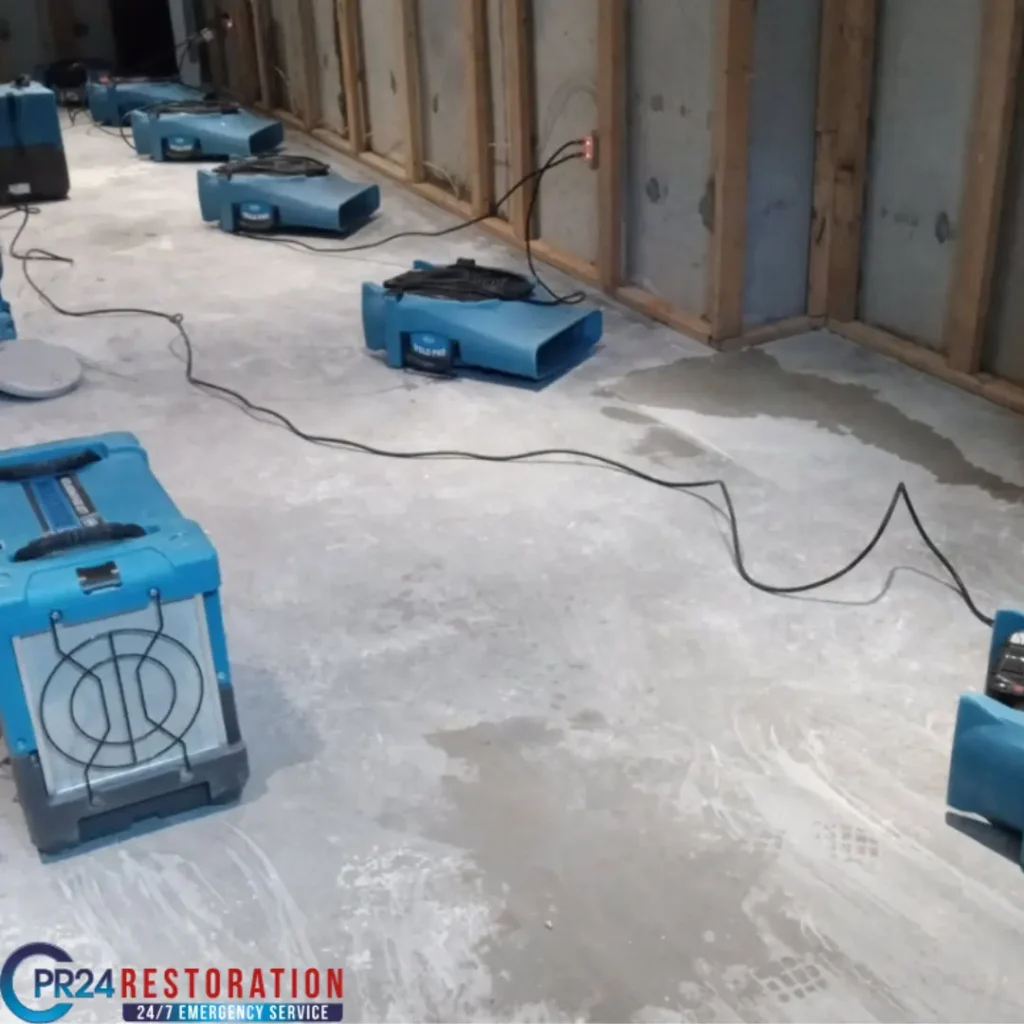
How to Prevent Burst Pipes
To prevent costly water damage from burst pipes in commercial spaces, consider these preventive measures:
- Allow faucets to gently flow during freezing weather, maintaining constant water movement to avoid frozen pipes.
- Introduce warm air circulation in cooler building areas.
- Apply heat tape to insulate and warm pipes efficiently.
- Seal any cracks or openings that allow cold air to enter, worsening weather issues.
- Maintain a minimum indoor temperature of 55 degrees Fahrenheit.
The Main Causes of Burst & Frozen Pipes
Burst pipes can happen for many reasons. They often occur because of too much pressure in the plumbing system. By understanding these common causes, property owners can take proactive steps to prevent catastrophic pipe failures. Let’s examine some of the primary culprits behind burst pipes:
Freezing Temperatures
One of the most frequent causes of burst pipes, especially in colder climates, is freezing water inside the pipes. As temperatures drop below freezing, any water left stagnant in pipes can turn to ice. Since water expands as it freezes, this creates immense pressure within the leaky pipe. Eventually, this pressure becomes too great for the pipe material to withstand, leading to cracks or complete ruptures.
Pipes that are most at risk of freezing are in unheated areas. These include basements, attics, and garages. Pipes that run water along outside walls with little insulation are also at risk. Outdoor pipes like garden hose bibs are also at high risk during cold snaps.
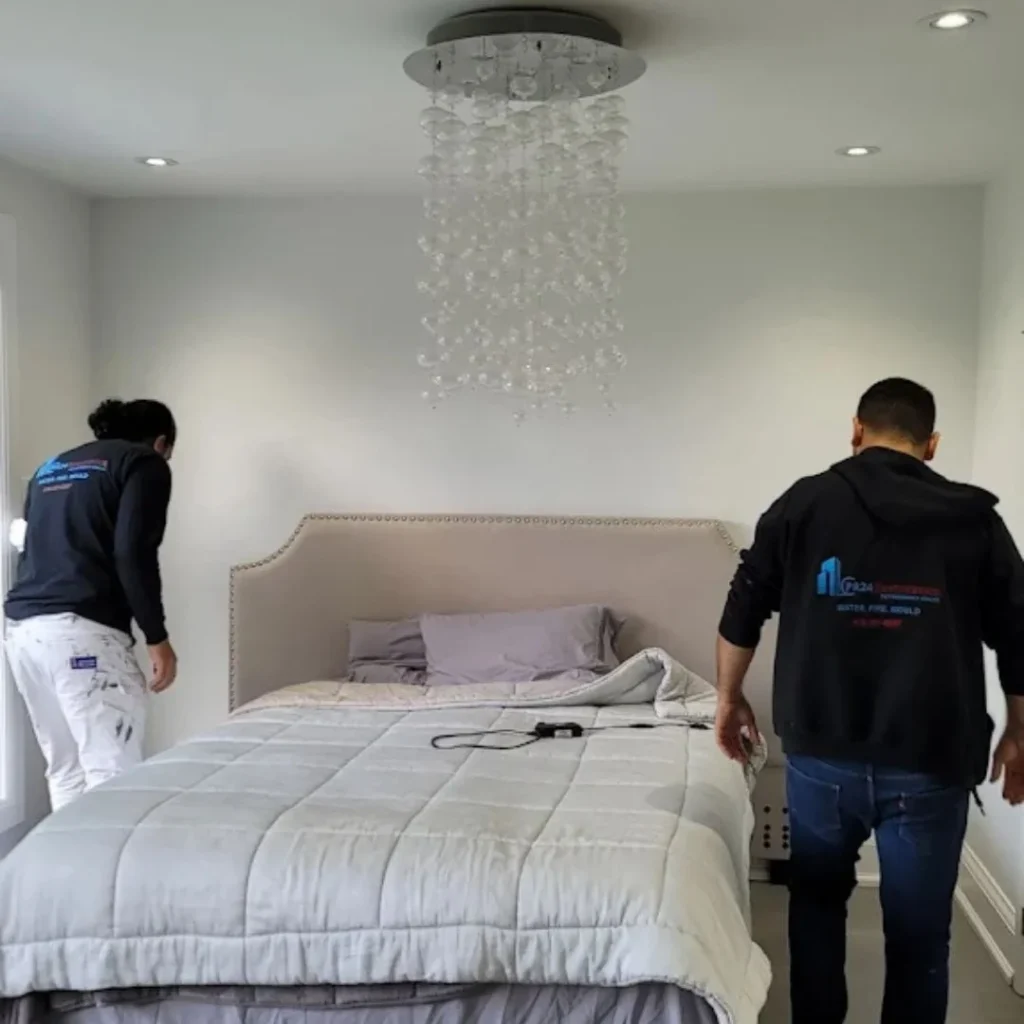
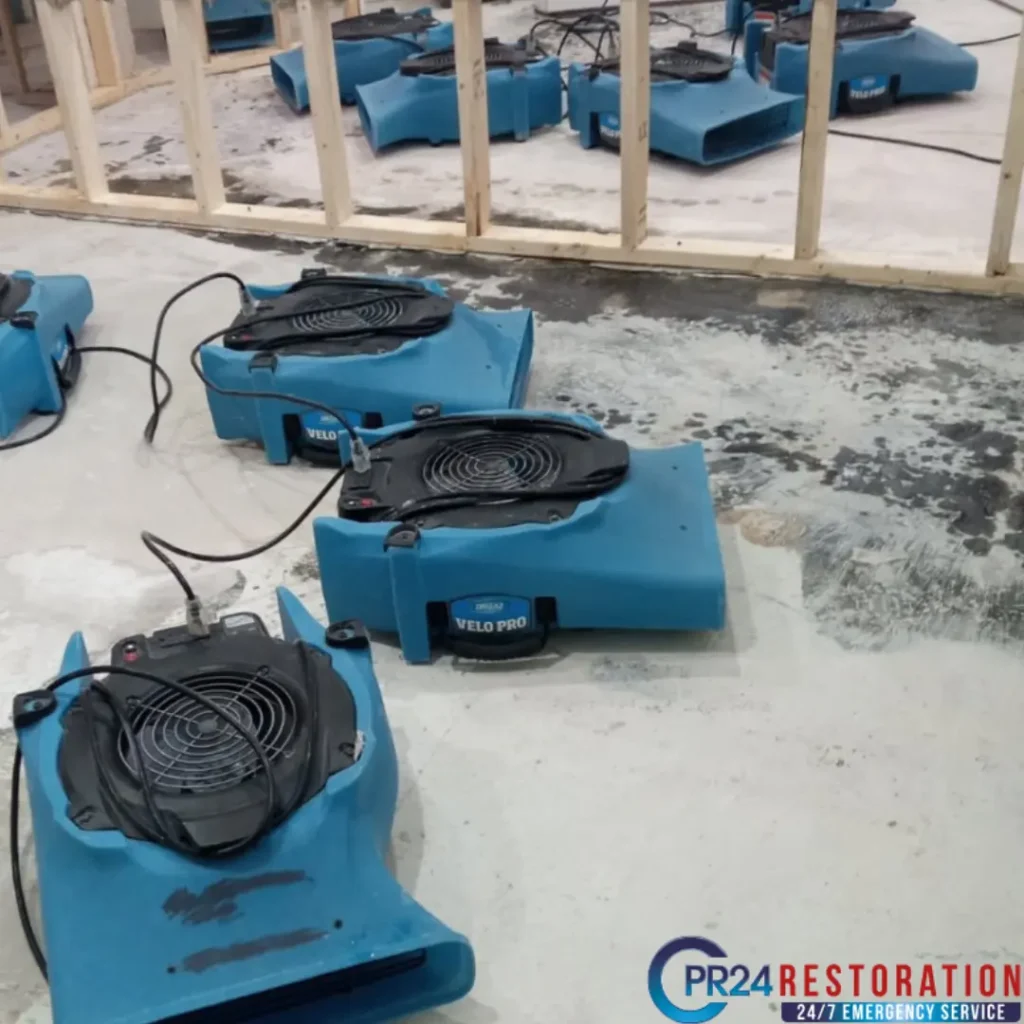
Old Infrastructure
Over time, pipes naturally degrade because of various factors including water quality, soil conditions, and normal wear and tear. Old metal pipes, especially those made of galvanized steel or cast iron, can corrode from the inside. This corrosion weakens the walls of the pipes. As corrosion progresses, pipes become more brittle and prone to pipe leaks or bursts, especially under high water pressure.
Even newer pipe materials like copper and PVC have finite lifespans. Regular inspections and timely replacements of aging plumbing components are essential for preventing unexpected failures.
Water Pressure Issues
High water pressure can put a lot of stress on pipes. This can cause leaks or bursts at weak spots in the system. Malfunctioning pressure regulators or improper settings often cause this.
On the other hand, sudden drops in water pressure can cause surges. This is called a “water hammer.” Over time, these surges can damage pipes. They can make pipes shift and weaken at the joints.
Physical Damage
Accidental impacts during renovation work, shifting soil around buried pipes, or even tree root intrusion can physically damage pipes. Once compromised, these weak spots become prime locations for future leaks or bursts. Knowing the location of pipes within walls and underground is crucial before undertaking any digging or construction projects.
Clogs and Blockages
Severe clogs in drains or sewer lines can cause water to back up and create localized areas of high pressure within the plumbing system. If not addressed, this pressure buildup can cause pipes to fail. This is especially true for older or weakened sections.
Improper Installation
Pipes that were not properly installed initially are at higher risk of failure. This can include several issues, for example:
– Using materials that don’t match.
– Not understanding how pipes expand and contract.
– Not providing enough support for heavy pipes. Professional installation by licensed plumbers is crucial for ensuring a long-lasting, reliable plumbing system.
By knowing these common causes, property owners can take steps to prevent problems. They can also watch their plumbing systems closely for any issues. Regular maintenance, quick repairs, and upgrades to old infrastructure can help prevent the trouble and cost of burst pipes.


Why Choose CPR24 Restoration for Water Damage Restoration?
Water pipe bursts in a house can sometimes occur abruptly, yet they’re often preventable. Water damage resulting from busted pipes poses a significant concern, capable of destroying your belongings and well-being. Responding swiftly is crucial in safeguarding your family and minimizing damage.
At CPR24 Restoration, our commitment lies in delivering unparalleled water damage restoration services. Our team of experienced experts is ready 24/7 to help with any water damage emergencies you may face. With our respected IICRC certification, we use the latest technologies and equipment. This ensures that you carefully restore your property to its original condition.
Contact CPR24 Restoration for Water Damage Restoration
Burst or frozen water pipes on your property require immediate attention. Contacting a trusted expert who can help you quickly during this crisis is important. This will give you peace of mind and immensely limit the stress you feel. Reach out to CPR24 Restoration, a reliable water damage restoration company near me without delay.
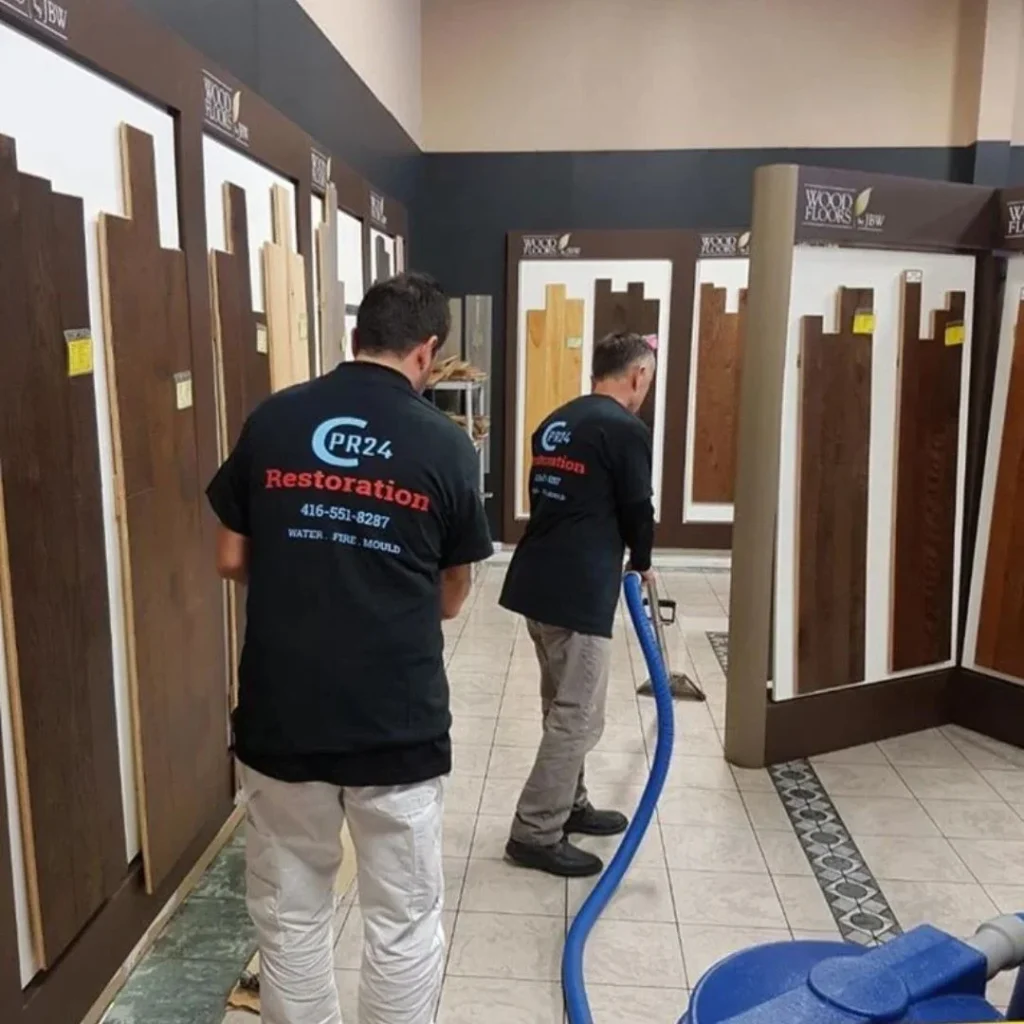
How It Works
Enter Details
Please provide as much information as possible about your emergency service and answer a few questions. Within minutes, we will be able to provide you with an expert. It’s easy and quick!
Book Assessment
Hire Us
We are the best restoration company in the GTA. We are continually working to improve our processes and remain updated on new techniques and methodologies.
It’s crucial to realize that several things influence the ultimate cost when estimating the cost of water damage repair. To restore your property to its pre-damage state, CPR24 Restoration is here to help you at every stage of the procedure. Let’s examine the main factors that affect the cost of water damage restoration in more detail.
- Area
One of the most important elements influencing restoration costs is the extent and size of the water-damaged region. Repair expenses increase with the size of the impacted region, whether it’s a minor leak or widespread flooding. The total cost of water damage restoration rises as larger areas require more work, supplies, and time to repair.
- Location
Due to geographical variations in labour costs, material availability, and situational urgency, geographic location might affect the cost of water damage repair. Because of the expense of living and logistics, properties in urban regions may have greater service fees than those in rural locations.
- What category is the water?
The type of water that caused the damage is crucial. Three criteria are commonly used to classify water damage:
Since Category 1 (Clean Water) uses water from clean sources like burst pipes or dripping faucets, it is the least expensive to clean.
Water from appliances or potentially contaminated sources, such as washing machines, sump pumps, and dishwashers, falls under Category 2 (Grey Water).
Category 3 (Black Water): This type of water, which originates from contaminated sources such as sewage, floodwater, or standing water in basements, is the most dangerous and costly to clean up. The cost is increased by the need for specific cleaning and sanitization for Category 3 water damage.
- Is there any water left?
Before beginning any additional repairs, any remaining water in the impacted areas must be removed. Because specialists need to use specialized equipment, including industrial-grade pumps and dehumidifiers, to extract the water and completely dry out the damaged areas, standing water might result in higher repair expenses. Long-term untreated water can encourage the formation of mold, which may necessitate more remediation and raise repair expenses.
- Other elements are present
The following additional variables could affect the price of restoring water damage:
Structural Damage: The walls, floors, and ceilings must be replaced or restored if water has weakened their structural integrity.
Growth of Mold and Mildew: Mold and mildew can appear if water damage is not addressed for an extended length of time. The overall cost of repair may rise dramatically with professional mold removal.
Materials Affected: If damaged beyond repair, some materials, like insulation, drywall, and hardwood floors, may need to be replaced completely. The cost of repairs increases with the cost of the materials.
Labour Intensity: Labour expenses will be impacted by the intricacy of the repair procedure, which may include demolition, cleaning, drying, and rebuilding.
- Emergency Services
Unexpected water damage can occasionally occur, necessitating prompt emergency water extraction and remediation services. Since emergency services must be provided quickly to stop additional damage, such the growth of mold or long-term structural problems, they are frequently more expensive.
Your property may suffer major repercussions from water damage, including mold growth and structural problems. To help you take preventative action and deal with issues before they become worse, CPR24 Restoration is here to explain the most typical causes of water damage. Let’s examine the main reasons why water damage occurs and how they may affect your house or place of business.
- Severe weather
One of the main sources of water damage is severe weather, such as hurricanes, heavy rain, or snow. Drainage systems can be swiftly overloaded by water, resulting in roof leaks, basement flooding, and even wall and floor damage. Extreme weather-related water damage is especially likely to occur in coastal locations or areas that get high rainfall.
- Clogged gutters
Gutter blockages caused by leaves, mud, and branches make it difficult for them to efficiently redirect water away from your house. This may cause gutters to overflow, allowing water to infiltrate into your property’s foundation and walls. Water seeping into your home from clogged gutters can eventually seriously harm your roof and even the interior of your house.
- Leaking pipes
Leaking or ruptured pipes are among the most frequent and frequently overlooked causes of water damage. Anywhere in your house, including behind walls, in basements, and beneath sinks, leaking pipes might appear. If a little leak is not fixed, it might cause significant water damage. In addition to age, corrosion, and inadequate installation, cold temperatures in the winter are also frequent causes of pipe leaks.
- Washing machine leak
Another common cause of water damage in houses is washing machines. Large volumes of water can pour into your floor from a malfunctioning hose, a worn-out gasket, or an overloaded machine, damaging nearby walls, hardwood floors, and carpets. To stop leaks, it’s critical to routinely check the hoses and connections on your washing machine.
- Condensation from AC
One prevalent yet obscure source of water damage is condensation from air conditioners. Improper drainage of your air conditioner can lead to the buildup of moisture and damage to adjacent walls, ceilings, and floors. This can eventually cause mould and mildew to grow and have a major impact on the air quality in your house. Preventing this problem requires routine cleaning and maintenance of your air conditioning system.
- Blocked drains
Water backup from clogged or blocked drains in sinks, showers, or toilets can harm ceilings and floors. Slow water drainage from blocked drains can cause standing water that could overflow and seep into floors and walls. To stop water buildup and any water damage, it’s critical to routinely remove any blockages in the drain.
- Malfunctioning sprinkler systems
Although automatic sprinkler systems are meant to hydrate your grass, they can cause serious water damage if they don’t work properly. Inadequate water distribution or sprinkler system leaks can cause an excessive amount of moisture to accumulate around your home’s foundation, which can lead to mould growth, wet basements, and foundation fractures. Costly damage to your sprinkler system can be avoided with routine testing and maintenance.
- Leaking water heater
If it starts to leak, your water heater is another typical cause of water damage. The surrounding area may flood due to a leaking water heater, causing damage to the walls and floors. Age, rust, and sediment accumulation can erode the water heater over time, raising the possibility of a leak. Significant damage from a broken water heater can be avoided with quick repairs and routine inspections.
- Roof Leaks
Water infiltration can occur from a roof that is old or broken, particularly during storms or periods of intense precipitation. Water seeping into your attic, walls, and ceilings due to roof leaks can result in mould growth, structural damage, and electrical risks. It’s critical to conduct routine roof inspections and fix any gaps, cracks, or missing shingles before they cause serious water damage.
- Sewer Backup
One of the most expensive and painful types of water damage is a sewage backlog. Basements and lower-level rooms may flood as a result of wastewater flowing back into your house due to clogged or damaged sewer lines. In order to reduce health risks, this kind of water damage is classified as black water (Category 3), which is extremely contaminated and necessitates professional cleanup and remediation.
There’s no denying that water damage can pose a number of serious health risks. If your home has been flooded with filthy water, you should be very concerned. Flood damage water is divided into three categories:
- Category 1: “Clean” water from hygienic sources, such as your home’s plumbing. Although this water has not yet been utilized in your home, it is still fresh and pure.
- Category 2: “Grey” water from outside your home, such as seepage from the earth into your basement and post-use water from home appliances.
- Category 3: Unsanitary sources of “black” water that may contain human or animal waste. This water comprises sewage-contaminated water as well as floodwater from rivers and lakes. This water should be treated as though it were poisonous.
If you’re dealing with Category 3 water, you should take a step back and ask for help right away. This water is potentially hazardous to touch or breathe, and anything it has come into contact with must is disposed of or thoroughly cleaned and sterilized. A skilled water damage restoration business will be able to tell you whether or not your contaminated possessions may be saved.
Floodwaters from outside your home can bring a wide range of germs, poisons, mold, and even fungi, even if they don’t contain raw sewage. If your home was flooded with anything other than clean tap water, your family could be exposed to these contaminants, necessitating sterilization operations.
Mold development is the most well-known threat of water damage. Mold spores might start to grow as soon as 24 hours following water damage. Mold has been linked to a variety of health conditions, ranging from allergy-like symptoms to major respiratory troubles and even neurological damage in some people. Mold isn’t something you want to deal with, so if you suspect mold is forming as a consequence of water damage or water that has been left sitting for more than 24 hours, the best thing you can do is hire a mold remediation company.
These toxins are obviously not things you want to sit around and multiply in your home, so dealing with water damage as soon as possible is critical. Water damage, on the other hand, isn’t just a health hazard in the form of biohazards; it can also undermine your home’s structure and components.
Backups of sewage are a nightmare. We don’t have to tell you that, though. If you’re having one, you probably have only one question on your mind. So, what should I do now? It’s easy to feel helpless in the face of the situation. It’s possible that your basement or living space is flooded. Keep calm, remember that things can be fixed, and continue reading.
If sewage backup is a recurring problem in your home, consult a plumber for a diagnosis and treatment plan. Even if the issue is not on your property, enlisting the help of a plumber can typically expedite the problem’s resolution. A plumber can frequently give evidence that the sewer problem is not on your property.
- Power down to the affected area.
- Stop wasting water.
- Put on your personal protection equipment.
- For insurance purposes, take images or videos of the affected area.
- Any damaged property should be disposed of.
- Using a shop vac, remove any standing wastewater or sewage.
- Bleach solution to mop
- Any wood or organic surfaces should be sprayed with a mold protection solution.
- Make use of a dehumidifier.
Sewage Backup and Flood Prevention
- Inspection of the Plumbing System on an Annual Basis
- Cleaning of Drains
- Installation of a backwater valve
Water damage in your home can be caused by a variety of factors. It could be the result of a plumbing issue, an overflowing bath, or floods caused by inclement weather. Whatever the cause of the damage, it’s critical to be aware of the warning signals and not to dismiss them when you see them. Pretending it isn’t there could result in further harm and troubles for your home and family. Here’s why, if you notice water damage, you shouldn’t disregard it.
- Structural Damage
- Mold and Mildew
- Health Problems
- Bad Smells
- Stains
- Increased Repair Costs
- Electrical Damage
- Water Damage Could Indicate a Bigger Problem
- Your Water Bills Might Be Too High
- It Can Worsen Quicker Than You Think
- Your Home’s Appearance Suffers
- There Could Be a Lot of Unseen Damage
- Your Insurance Could Be Affected
- Flooding Can Cause Foundation Damage
- Fixing Water Damage Prepares You For Future Problems
Water damage requires immediate action. As soon as you notice a leak, flood, or overflow in your commercial and residential property, you should contact an emergency restoration company for water damage removal.
As you await the quick arrival of the IICRC-certified restoration team at CPR24 Restoration, you should turn off any electrical breakers in the affected area, and stay away from hazards.
Any furniture that has been affected or damaged, such as carpet, couches, tables, flooring, and other building materials, should be removed promptly. Dispose of any contaminated materials in a safe manner. This will help minimize the need for mold removal.
Now that the area is clear, it is time to extract the water and dry the affected areas with the appropriate equipment. While a dehumidifier may be accessible to the general public, it may be tough to find pumps and blower fans that are readily available. By contacting CPR24 Restoration promptly, our team will arrive on-site in a timely manner to manage the water damage cleanup process, mold removal if necessary, and even reconstruction.
Secondary water damage is the type of damage that can occur as a result of floods and leaks such as mold and electrical issues. These are a noteworthy issue for property owners, particularly if it isn’t tended to in a timely manner. Secondary water damage can cause the development of mold growth, oxidized metal, decayed wood, and bowing floorboards.
How Does Secondary Water Damage Happen
After water damage occurs in a home, mold growth soon follows. Within two days, the first signs of mold growth can become apparent. If not addressed promptly, mold can spread extensively. Mold spores can cause respiratory problems, allergies, and other health issues for occupants. To remove the mold thoroughly and protect against future growth, homeowners should consult with the mold removal pros at CPR24 Restorations. Our professionals are able to eliminate any existing mold safely and take the necessary steps to prevent further mold from developing. Our assistance ensures that water damage will not lead to larger health concerns down the road.
Oxidized metal is another kind of secondary water damage that can develop. If metal is exposed to moisture for a prolonged time, it will start to rust, weakening the material and potentially causing deterioration. Decayed wood is also a frequent problem that can surface after water damage has struck. It can undermine the integrity of a structure and generate an unsafe condition for occupants.
Warped and uneven floorboards can develop as another consequence of secondary water damage. If water infiltrates between floorboards, it has the potential to distort their shape and cause them to lift, posing stumbling risks and allowing further destruction to take place if not handled without delay.
Protect Your Property with Water Damage Restoration
It’s important to address secondary water damage promptly to prevent further damage and potential health hazards. Homeowners should consult with the professionals at CPR24 Restorations, we can help you identify and address these issues effectively and safely. By taking prompt action, homeowners can minimize the damage and ensure that their homes remain safe and healthy places to live.
24/7 Water Damage and Mold Removal Services
Contact Us Today

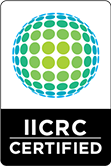
Why Choose Us

Appointments

Fast Service

Experience

Certified Mold Removal & Remediation Company

Workmanship

Approved Pricing
Contact Us Now
Featured CPR24 Restoration Projects
At CPR24 Restoration, we take pride in delivering high-quality restoration services that help homeowners and businesses recover from disasters. Our featured projects showcase real-life examples of water damage restoration, mold removal, fire damage recovery, and more. Each project highlights our expertise, rapid response, and commitment to restoring properties efficiently and safely. From minor repairs to full-scale restorations, we ensure every job is completed with precision and care.
What Our Clients Are Saying
Trustindex verifies that the original source of the review is Google. We consider ourselves fortunate to have happened upon CPR24 Restoration via a Google search when we were in need of remediation work for a mold issue in our basement. The glowing reviews prompted us to call and we quickly became aware of why this company has met with so much success. As soon as Chris arrived we could see his mind turn to problem-solving mode. He assessed our situation, outlined the work that needed to be done and most importantly provided reassurances that his team could get right on it. It gave us peace of mind to know that CPR24 could not only deal with the mold issue but also put everything back together and refresh all the areas involved. Not having to go in search of renovation contractors was particularly important to us as we had time constraints to get the work done. We were impressed by the efficiency of the trades and the respect shown to us and our home by all the workers involved. And it was nice to see some of the same faces throughout the project which provided continuity for us. It was evident that these individuals took pride in their work and were committed to a job well done. We thank CPR24 for its professionalism and timely service and certainly recommend it for your restoration needs.Trustindex verifies that the original source of the review is Google. I had a flood in my basement and I called right away to get help. The team was extremely professional and efficient. They were with me every step of the way, and answered all the questions that I had. This is by far one of the most professional companies I have ever had the pleasure of dealing with. I would recommend them to everyone that I know because they really care about their work and they treat the customer with the upmost importance and respectTrustindex verifies that the original source of the review is Google. Outstanding service from CPR Restoration! They were fast, professional, and took care of everything with great attention to detail. Highly recommend for any restoration needs.Trustindex verifies that the original source of the review is Google. Recently found mold in my attic, called CPR24 Restoration after finding them on the first page of Google. They picked up the phone straight away and gave me a whole detailed rundown on the steps that would need to be taken in my attic. They were very professional and efficient throughout the entire process. Overall excellent mold removal and remediation company with quick and professional service. Beyond satisfied with the results! Will be recommending to my friends&family.Trustindex verifies that the original source of the review is Google. I called CPR24 Restoration after a condo water leak I recently experienced. After searching flood companies on Google and countless calls with other companies, CPR24 Restoration was the one that stood out to me most and was honestly most helpful throughout the entire process. Chris was quick to answer the phone, and they were the only company that gave me a clear outline of the water damage and flooding process. He met with me the same day of my phone call and was always very punctual. The team was very patient with me, they helped answer all of my many questions and were always very quick to respond if I had any issues throughout the week. I really appreciated how supportive Chris and his team were throughout the entire process. Highly recommend CPR24 Restoration!Trustindex verifies that the original source of the review is Google. I had an amazing experience with CPR24 Restoration. I had mold in my basement and they were very quick and easy. Great customer service, Highly recommend.Trustindex verifies that the original source of the review is Google. My sister recommended CPR24 Restoration for flood damage and mold removal. I started to smell mold in my basement last week, I called Chris and he was there within the hour. I am so relieved I called him when I did because there were signs of toxic black mold which their team removed very efficiently. Staff was friendly and very punctual. Overall 10/10 experience!Trustindex verifies that the original source of the review is Google. Recently I had mold problem in my basement Chris from CPR Restoration came with his professional team and took care of the situation I recommended them to all my friends great company to callTrustindex verifies that the original source of the review is Google. I want to share my wonderful experience with CPR24 Restoration whom I highly recommend to others looking for mold removal companies. I called CPR24 Restoration for the toxic black mold I had in my basement, after finding them on Google. They were always on time, responded quick to my emails, and made me feel very secure throughout the whole process. Their team was very efficient but extremely careful at the same time. So professional and will definitely be keeping their contact for the future.Trustindex verifies that the original source of the review is Google. I was so stressed out though, but Chris and his team are well organised, skilled, well mannered and very friendly. Anytime I called him, he replied. His main focus on client’s satisfaction. He is a very sincere person. Thanks very much to CPR24.
Related Blog Posts
Basements naturally face flooding risks because they sit at a building’s lowest level, below ground level. Heavy rains create multiple water intrusion paths through foundation cracks, overwhelmed drainage systems, and sewer backups. Your basement needs quick action, whether you’re dealing with current flooding or want to prevent future problems. We
That pink mold you spotted in your Toronto home isn’t actually mold at all. The strange pink substance is a type of bacteria called Serratia marcescens. For effective pink mold removal, it’s important to address it promptly as it thrives in warm, moist places like your humidifier. A pinkish film has
Your home might harbour more mold dangers than you realize. Mold spores exist everywhere, including our homes, and they thrive on any surface that provides enough moisture. People who live in moldy, damp homes tend to experience eye, nose, and throat irritation. They also report coughing, wheezing, and their asthma symptoms
Water damage tops the list of insurance claims by condo owners, according to the Insurance Bureau of Canada. Condo owners can avoid major financial headaches by understanding their responsibilities during water damage incidents. Condo master insurance policies often carry hefty deductibles. These amounts can reach $50,000 or even $100,000. The
What to do in the first 60 minutes of a home flood in Toronto? Time matters when disaster strikes, and contacting an emergency flood service can make all the difference. Water damage spreads faster, and untreated areas can become mold breeding grounds within 24-48 hours. Homeowners face immense stress from flood
Disaster can strike your property anytime, and Restoration Toronto services become your recovery lifeline. Professional restoration companies have the skills to help save your home or business from water damage. Our team has 15 years of experience. We have noticed a significant increase in searches for “restoration companies near me”



